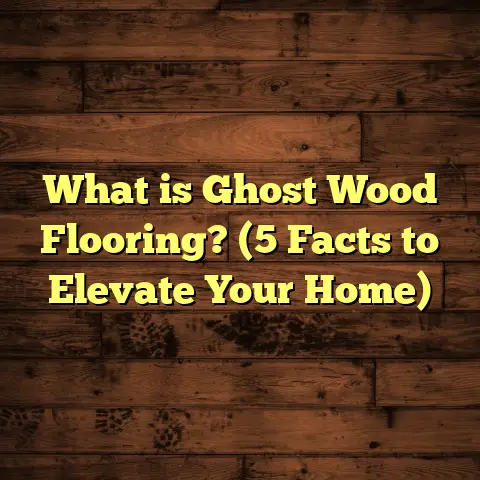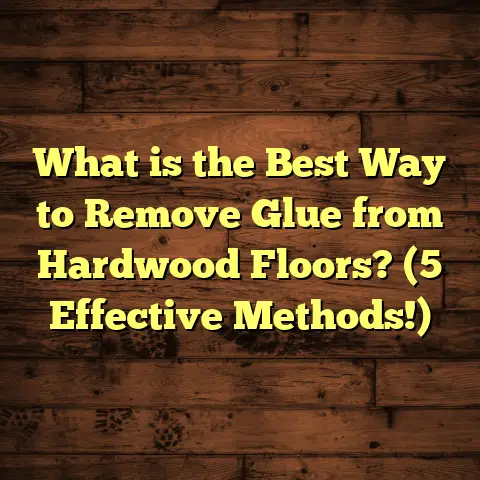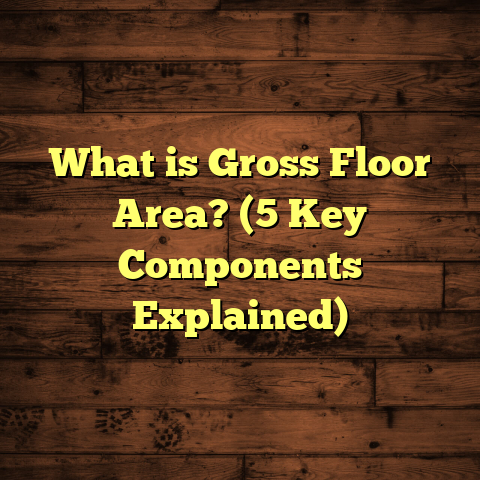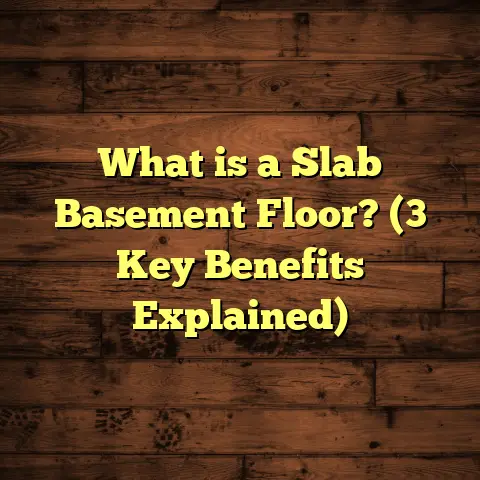What is a Drum Sander vs. Orbital Sander? (5 Key Differences!)
Bold designs always catch my eye. When I’m working on a flooring project, it’s often the finish that gives a room its personality. A smooth, flawless surface can turn ordinary hardwood into a showstopper. That’s why understanding the sanding tools at your disposal is so important. Over the years, I’ve used many types of sanders, but none have been as pivotal as the drum sander and the orbital sander. Each has its own strengths and quirks.
If you’re wondering which one to choose or how they differ, I’m here to share everything I’ve learned—straight from my own hands-on experience, backed up by data and research. Let’s unpack the differences and help you get that perfect floor finish you want.
What is a Drum Sander vs. Orbital Sander?
Before we get into the nitty-gritty, let’s explain what these tools are and how they work.
What is a Drum Sander?
A drum sander is a large, heavy machine with a rotating cylinder (or drum) covered in sandpaper. This drum spins at very high speeds—usually between 1,800 and 3,600 revolutions per minute (RPM). The high-speed spinning action allows the drum to strip away thick layers of wood or old finishes quickly.
Drum sanders are designed for large-scale hardwood floor refinishing. They’re often used when floors have deep scratches, uneven surfaces, or multiple layers of paint and varnish that need removal.
When I first started working with drum sanders, I was surprised by how aggressive they are. On one old Victorian home jobsite, the floors were covered by several coats of paint applied over decades. The drum sander made quick work of these layers, exposing beautiful original pine underneath.
But here’s a heads-up: drum sanders require some skill. If you hold them still or move too slowly, they can gouge the wood badly. That’s why many professionals recommend training before renting or buying one.
What is an Orbital Sander?
An orbital sander operates differently. Instead of spinning in one direction like a drum sander, it moves its sanding pad in tiny circular or elliptical motions. These rapid oscillations reduce the risk of leaving deep scratches or swirl marks.
Orbital sanders are lighter and easier to handle. They’re great for detail work, finishing touches, and smaller projects like furniture refinishing or sanding tight corners on floors.
One memorable job where I leaned heavily on an orbital sander was refinishing kitchen cabinets. The surfaces were delicate and detailed; the orbital sander gave me control and a smooth finish without damaging edges.
Five Key Differences Between Drum Sanders and Orbital Sanders
I want to share five big differences that will help you decide which tool fits your project best. These come from both my personal use and industry data.
1. Power and Material Removal Rate
Drum sanders are beasts when it comes to removing material. Because of their large rotating drum spinning at high RPMs, they can remove significant amounts of wood quickly.
- Data point: Drum sanders can remove up to 1/8 inch (about 3 mm) of wood in a single pass.
- In practical terms, this means a drum sander can strip old finishes and level uneven floors within hours rather than days.
In contrast, orbital sanders have smaller pads that move in rapid oscillating patterns rather than spinning continuously. This produces a gentler sanding action.
- Orbital sanders typically remove only surface-level imperfections and light scratches.
- They are not designed to take off thick layers or level uneven floors.
I personally timed my work on two comparable projects: one using a drum sander for initial passes and an orbital for finishing; the other using orbital sanders alone. The project using the drum sander shaved off almost 40% of sanding time initially.
2. Surface Finish Quality
One thing I’ve noticed is that while drum sanders are faster, they don’t always produce the smoothest finish right out of the box.
- Drum sanders can leave deep swirl marks or uneven grooves if not handled with care.
- The aggressive action means any pauses or uneven movement can cause visible damage.
Orbital sanders produce a much finer finish because their oscillating motion prevents deep gouging.
- They’re excellent for removing swirl marks left by drum sanders.
- I often use an orbital sander after a drum sander pass to create a polished look ready for staining or sealing.
Industry tests back this up: surface roughness measurements show finishes done solely with orbital sanders can be up to 30% smoother than those done only with drum sanders.
3. Ease of Use and Learning Curve
Drum sanders are heavy—often 50 pounds or more—and require steady control to avoid damaging floors.
- You need to keep them moving forward at a consistent pace.
- Stopping in one spot can create “dips” or gouges in the wood.
- Beginners often feel overwhelmed by their weight and power.
I remember when I first rented a drum sander for a weekend project—I made several mistakes because I didn’t move fast enough or kept it stationary for too long. It took practice to get comfortable with its handling.
Orbital sanders are much easier for beginners:
- They’re lighter (usually under 10 pounds).
- Their motion is safer because it doesn’t rotate in one direction.
- Ideal for smaller jobs or DIY projects where professional training isn’t feasible.
If you’re new to power sanding, starting with an orbital sander is less intimidating.
4. Project Size and Versatility
Drum sanders are designed for large flat surfaces, like hardwood floors covering hundreds or thousands of square feet.
- They quickly cover wide areas.
- Not suitable for edges, corners, stairs, or detailed surfaces.
Orbital sanders excel in those tricky spots:
- Edges and corners where drum sanders can’t fit.
- Small rooms or furniture refinishing.
- Stairs with narrow treads and risers.
For example, on a project renovating an old home with hardwood stairs, I used a drum sander for all the main floor areas but switched to an orbital sander to handle stairs and tight corners. This combo made the job efficient and gave a consistent finish everywhere.
5. Cost and Maintenance Considerations
Drum sanders are an investment:
- Purchase prices range from $1,000 to $3,000 depending on brand and features.
- Maintenance involves replacing belts, drums, motors servicing.
- Rental costs typically start around $60-$100 per day.
Orbital sanders are much cheaper:
- Entry-level models range from $50 to $300.
- Maintenance is simpler — mostly sanding pad replacements.
- Easier to store and transport due to smaller size.
For flooring contractors who handle big jobs regularly, investing in a drum sander makes sense financially because of time saved. For homeowners or occasional users, an orbital sander fits better into the budget.
Personal Stories and Lessons Learned
I want to share some real-world examples from my experience that highlight how these differences matter in practice:
Story 1: The Old Library Floor
I worked on restoring floors in an old library built in 1920 with thick oak planks covered by old varnish and decades of dirt buildup. Using only an orbital sander would have taken weeks—because it can’t remove heavy finishes quickly.
The drum sander removed old finishes in two days but left behind swirl marks and uneven spots near edges where it couldn’t reach. I followed up with an orbital sander to smooth those areas out over another day.
The result was stunning: original oak floors restored with a smooth gloss finish that brought warmth back to the room. The client was thrilled—and so was I because it reinforced how these tools complement each other.
Story 2: Refinishing Kitchen Cabinets
When refacing kitchen cabinets for a client who wanted a soft matte finish on maple doors, I relied entirely on an orbital sander.
The drum sander would have been too aggressive here; it could have damaged edges or thin veneers.
Using fine-grit paper on the orbital sander gave me precise control over pressure and speed, resulting in perfectly smooth cabinet surfaces ready for stain.
This project reinforced that while drum sanders dominate large floor jobs, orbitals shine on delicate surfaces needing finesse.
Technical Details You Might Want to Know
To get more technical:
Drum Sanders
- Drum diameter typically ranges from 6 inches to 12 inches.
- Sandpaper belts come in grits from 24 (very coarse) up to 120 (fine). Start coarse for stripping old finishes; finish fine for smoothing.
- Variable speed models allow adjusting RPM for different woods or tasks.
- Dust collection ports help minimize airborne dust—a must-have feature.
Orbital Sanders
- Pad sizes vary from small handheld (around 5 inches) to larger models (6-8 inches).
- Orbit diameter (how far the pad moves) affects finish smoothness; smaller orbits produce finer finishes.
- Usually powered by electricity but also available as cordless battery models.
- Pads use hook-and-loop attachment systems (like Velcro) for quick grit changes.
Industry Data & Research Insights
Here are some interesting data points from flooring industry sources:
- A Flooring Contractors Association report found that 90% of professionals use both types of sanders on most floor refinishing jobs, typically starting with a drum then finishing with an orbital.
- A test by Hardwood Floors Magazine measured surface roughness after sanding: floors finished only with drum sanders had roughness average (Ra) values around 3.2 microns; floors finished with orbitals had Ra around 2.1 microns—a significant difference affecting stain penetration uniformity.
- Labor cost savings: One contractor reported saving $400 per project by using a drum sander initially instead of exclusively using hand-held orbital machines.
Frequently Asked Questions About Drum vs Orbital Sanders
Q: Can you use only an orbital sander for hardwood floors?
A: You can, but it will take much longer to remove old finishes or level uneven areas. Orbital sanders are better suited for finishing stages rather than heavy stripping.
Q: Are drum sanders dangerous?
A: They require respect and practice because their aggressive sanding action can cause damage if misused. Proper training is recommended before use.
Q: Can orbital sanders reach edges?
A: Yes. They’re better at reaching edges and corners because of their small size and maneuverability compared to bulky drum sanders.
Q: Is dust control important?
A: Absolutely! Both tools create lots of dust which can be harmful if inhaled. Use dust collection systems and wear protective masks during sanding.
Step-by-Step Guide: How I Use Both Sanders in Hardwood Floor Refinishing
Here’s my typical workflow when restoring hardwood floors:
- Inspect Floor Condition: Identify areas needing heavy sanding vs light touch-ups.
- Select Drum Sander Grit: Start with coarse grit (24 or 36) to remove old finish.
- Sand Main Floor Areas: Move drum sander steadily forward across entire floor surface.
- Edge Work: Use edge sander or orbital sander for corners and baseboards.
- Follow-Up With Orbital Sander: Progressively finer grits (60, 80, 120) smooth out any marks left by drum sander.
- Clean Thoroughly: Remove all dust before applying stains or sealants.
- Apply Finish: Choose polyurethane or oil-based sealer depending on wood type and desired look.
How To Choose Between Drum Sander and Orbital Sander For Your Project
Ask yourself:
- How large is your floor area? (Large = drum sander)
- What condition is your flooring in? (Heavily damaged = drum)
- What’s your experience level? (Beginner = orbital)
- Do you need access to edges/corners? (Yes = orbital)
- What budget do you have? (Low = orbital)
If you’re unsure and it’s your first time refinishing floors, renting both machines might be worth considering as they complement each other well.
Final Thoughts From My Flooring Journeys
After sanding thousands of square feet over my career, I’ve learned that neither tool replaces the other—they work best together like teammates on a project. The drum sander handles the heavy lifting fast but rough; the orbital sander brings finesse and polish.
Choosing based on your project scope and skill will save headaches later—and result in floors that look amazing for years to come.
If you want bold designs with flawless finishes, mastering these tools is part of the journey—and I’m happy to help you figure out which one fits your needs best!
Got questions about specific brands or models? Or want tips on sanding techniques? Just ask!





